Rickers Endow Faculty Positions and a Scholarship at Eastman
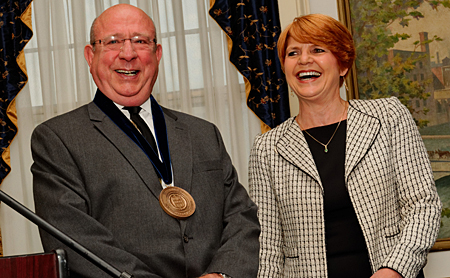 While studying clarinet, 16-year-old Ramon “Ray” Ricker ’73E (DMA) developed an interest in jazz that led him to begin taking saxophone lessons. Over the course of more than 50 years, Ricker’s interest became his passion. Now his passion has become his gift to the Eastman School of Music.
While studying clarinet, 16-year-old Ramon “Ray” Ricker ’73E (DMA) developed an interest in jazz that led him to begin taking saxophone lessons. Over the course of more than 50 years, Ricker’s interest became his passion. Now his passion has become his gift to the Eastman School of Music.
Ray, professor emeritus of saxophone, and his wife, Judith Ricker ’76E (BM), ’81E (MM), ’91S (MBA), have committed a significant gift to faculty and student support at Eastman. The Rickers’ gift will endow two faculty positions—a professor of saxophone and a professor of jazz saxophone—and a scholarship fund to support talented classical and jazz saxophone students at Eastman who have demonstrated financial need. The Rickers also support Eastman and Simon Business School annual funds as members of the George Eastman Circle.
After serving at Eastman for more than 40 years as a faculty artist, a professor, and an administrator, Ray retired in the spring of 2013. During his tenure as senior associate dean for professional studies and director of the Institute for Music Leadership (IML), he helped shape the School’s entrepreneurship programs and initiatives.
In September 2013, the Eastman School recognized Ray’s leadership and his joint philanthropy with Judith by awarding him the 2013 Eastman Dean’s Medal. Established in 2008, the Dean’s Medal recognizes extraordinary service, philanthropy, and leadership to the Eastman School of Music, and dedication and commitment that inspire others to take leadership roles at the University. It is among the highest honors given by the School.
After graduating from Eastman, Judith went on to play oboe for the Rochester Philharmonic Orchestra for 15 years. She also taught at the Hochstein School of Music & Dance. Judith recently retired from her position as executive vice president of brand research at the marketing research firm Market Probe and is currently working as an independent consultant. In 2012, she was awarded the “Great Minds Silver Innovation Award” by the Advertising Research Foundation. The award recognized her research on what drives consumers’ passion for brands in various industries and over time.
Ray, as a professional musician and music contractor, has performed on hundreds of television commercials and program themes, including national accounts for NBC, ABC, Cinemax, HBO, and Arts and Entertainment. His books on jazz improvisation and saxophone technique, as well as many of his compositions, are viewed as standards in the field—more than 150,000 copies have been sold worldwide with French and Japanese translations. His latest book, Lessons From a Street-Wise Professor: What You Won’t Learn at Most Music Schools was chosen as a finalist in the “Business: Entrepreneurship and Small Business” category for the USA Best Books Awards in 2011.
A Meliora Message
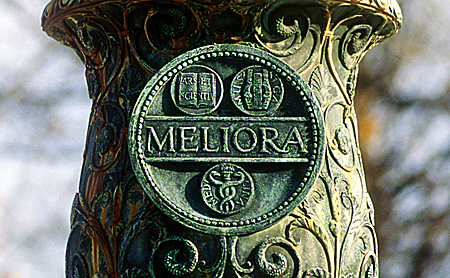
Any of us of a certain age probably share a common experience… Sitting in front of the television fighting to stay awake to watch the Jerry Lewis MDA Telethon. As the hour grew late—or early, depending on how you looked at it—many of us fell asleep as someone was spinning plates or as poodles in tutus were walking on their hind legs.
That’s about the time that the pledges slowed down and we often wondered if they would reach their goal.
Momentum.
It lagged at that point. Were people confident that Jerry would surely reach the goal? Or were they just waiting until it was closer at hand to do their part?
We’ve entered a critical phase of The Meliora Challenge: The Campaign for the University of Rochester where we can't begin to feel certain that our goal is within easy reach and we can't surrender to temptation to save our efforts for the home stretch.
We’ve been able to do amazing things, as you’ll see in this issue, thanks to generous benefactors and their meaningful gifts. We’ve created scholarships and endowed professorships. And we’ve renovated and built halls that will be home to entertainment and learning and healing for as long as there is a University of Rochester.
And we’ve built something else that isn’t going away.
Momentum.
Meliora Weekend 2013
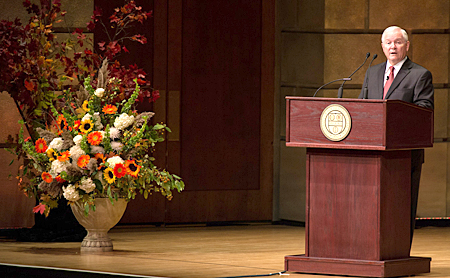 Former Secretary of Defense Robert Gates gives keynote address at Kodak Hall
Former Secretary of Defense Robert Gates gives keynote address at Kodak Hall
An open exchange of ideas. Connections that last a lifetime. And a good dose of laughter.
Those are some of the things that Meliora Weekend is all about.
And they were on display when Representative Barney Frank and Professor Arthur Miller ’56, ’08 (LLD) sat down in this year’s Combined Presidential Symposium-Miller's Court on “Great Issues of the 21st Century.” Introduced by Hugo Sonnenschein ’61, University trustee and president emeritus of the University of Chicago, the conversation was punctuated by Frank’s unique sense of humor and flavored by his friendship with Miller of more than 40 years.
It was just one event in four days full of interesting discussions, renewed relationships, memories recalled, and new ones made. As always, Meliora Weekend was anchored by the reason many come back to campus year after year—the chance to reunite with classmates and faculty. A number of classes enjoyed reunions including the 50th reunion of the Class of 1963. Fans basked in the sun and in the Yellowjackets’ 38–13 gridiron win over Alfred State College. Students from across the University entertained in dozens of performances. And more than 6,200 attendees enjoyed a weekend full of stellar events and even better weather.
On Saturday, former Secretary of Defense Robert Gates took a packed audience in Eastman Theatre’s Kodak Hall on a journey around the globe, stopping to give his perspective and insights at milestone events and at a variety of trouble spots, including one of the most troubling spots of all—Washington, D.C. Despite the grave nature of Gates’ former responsibilities, he left the audience with a sense of optimism that he emphasized grows at great research universities like Rochester.
On Friday evening, the George Eastman Circle welcomed Wall Street Journal columnist Peggy Noonan who talked of leadership and her unique relationships with Presidents George H. W. Bush and Ronald Reagan. It was a fitting theme for many of the leaders of The Meliora Challenge who gathered to hear her thoughts and insights. Comedian Demetri Martin, former writer at Late Night with Conan O’Brien and regular performer on The Daily Show with Jon Stewart, entertained a full house in the Palestra.
MEL Talks—new to Meliora Weekend—gathered some of our most dynamic alumni, faculty, and students to share ideas, experiences, and opportunities. And the topics they discussed were as diverse and far ranging as the people who make up the University community. Mark Noble, director of the University of Rochester Stem Cell and Regenerative Medicine Institute, emphasized the importance of funding research and highlighted the University’s stem cell programs and their potential for revolutionizing treatment of cancer, spinal cord injury, and genetic disorders. Kathy Rideout ’95W (EdD), dean of the School of Nursing, discussed the impending shortage of primary care providers and how nurse practitioners, urgent care centers, and other providers might step up to avert this looming crisis. Dana Mittleman ’05 spoke passionately about her experience of taking the President of the United States’ carefully chosen words and expressing them in American Sign Language. And John Covach, the Mercer Brugler Distinguished Teaching Professor in the School of Arts & Sciences, presented “Out of Nowhere: The Surprising Emergence of Elvis Presley and The Beatles.” As we said, diverse.
And 50 years after one of the most transformative years in our nation’s history, three alumni sat down to talk about what it was like to be on campus in the fall of 1963, when the International Club first took shape. The College Diversity Roundtable, moderated by Michelle Thompson-Taylor, director of the University’s Intercultural Center, brought together Dorothea de Zafra Atwell ’63, Brian Fleming ’63, and Payne Masuku ’65 for a discussion on what it was like to be on campus as students from around the world came together for the first time.
Meliora Weekend 2013 has come and gone. For many reasons—from the guests to the weather—it will be remembered as a perfect example of the University of Rochester at its finest. To view photos from the weekend, click here.
Rettner Hall Formally Dedicated
 100 years from now, when the University gathers to celebrate the anniversary of the dedication of Ronald Rettner Hall for Media Arts and Innovation, as we recently did for the Memorial Art Gallery, none of us will be here.
100 years from now, when the University gathers to celebrate the anniversary of the dedication of Ronald Rettner Hall for Media Arts and Innovation, as we recently did for the Memorial Art Gallery, none of us will be here.
Except Ron Rettner.
As President Joel Seligman said in his opening remarks, with such a momentous gift comes a degree of immortality. “Eastman. Strong. Bausch and Lomb. Goergen. These are some of the names on our buildings. And now, Rettner. It bespeaks a legacy that will stretch to classes tens of years, perhaps hundreds of years, from now.”
Ron Rettner will be there every time a student climbs the signature staircase to work in the open labs and state-of-the-art studios or when students from many disciplines sit and talk about new solutions and think in new ways. His legacy will be there in brick and mortar, but it will also live on through countless students and innumerable innovations.
On October 11, Rettner, a University trustee, and his family were joined by President Seligman, Board Chair Ed Hajim ’58, City of Rochester Mayor Tom Richards, former Congressman Joseph DioGuardi, and other invited guests to formally dedicate the building that promises to be at the center of University learning—both in its location and its philosophy.
Sadé Richardson ’15 spoke of how Rettner Hall will be a home to her and to students for generations to come. “I envision Rettner Hall as a place for students to come together and share their different ideas and abilities to enhance the learning environment for us all.”
And Tom DiPiero, dean for Humanities and Interdisciplinary Studies, stressed that Rettner Hall will be a home to many of the values—invention and imagination, creativity and collaboration—that define the new majors of digital media studies and audio and music engineering that will be housed there. “The whole point to Rettner Hall is to inspire students to think collaboratively. It will make the way we deliver education something to be emulated. We’re all extremely grateful to Ron Rettner for making this vision possible.”
A ribbon cutting followed the dedication ceremony and Rabbi Asher Yaras offered a benediction before Rettner Hall’s doors were opened to one and all for an open house.
And that’s what it promises to be, far into the future.
Porsteinsson Installed as Inaugural Konar Professor
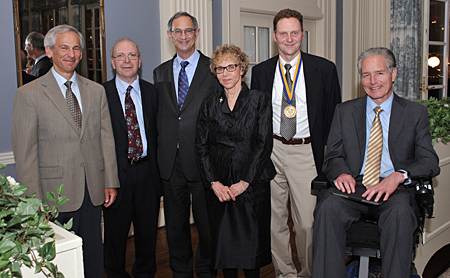 Howard Konar; Mark Taubman, M.D., President Joel Seligman, Sheila Konar, Anton Porsteinsson, M.D. and Bradford Berk ’81M (MD), ’81M (PhD)
Howard Konar; Mark Taubman, M.D., President Joel Seligman, Sheila Konar, Anton Porsteinsson, M.D. and Bradford Berk ’81M (MD), ’81M (PhD)
Count to 68. That’s about how long it takes for someone in America to develop Alzheimer’s disease.
Today, there are more than 5 million who suffer with Alzheimer’s. By 2050, the rate at which people develop Alzheimer’s is expected to more than double, and the number of people living with the disease is projected to almost triple. These estimations would make Alzheimer’s the leading cause of death nationally, eclipsing heart disease and cancer.
These are scary statistics. However, Anton P. Porsteinsson ’93M (Res), director of the Alzheimer’s Disease Care, Research and Education Program, is a reason to be optimistic. Porsteinsson is an internationally renowned clinical researcher and a leading expert in Alzheimer’s disease and dementia, which only begins to demonstrate why he was installed as the inaugural William and Sheila Konar Endowed Professor.
On October 2, a ceremony recognized Porsteinsson’s extraordinary contributions to the Departments of Psychology and Neurology and more than three decades of support from his benefactors, William (Bill) and Sheila Konar.
“The Konars’ generosity and leadership will lead to new ways of preventing and treating Alzheimer’s disease and other brain diseases that affect memory, thinking, behavior, and mood,” said President Joel Seligman. “From the bottom of my heart, I thank the Konars for their determination to help rid the world of a vicious disease that has touched so many of us.”
Bill Konar is the founder of William B. Konar Enterprises, which owns apartments, townhouses, warehouses, and industrial parks in Rochester. An active community volunteer, Sheila Konar has served as a board member of the Rochester-area chapter of the Alzheimer’s Association and volunteers at Rochester City School District’s Henry W. Longfellow School No. 36.
The Konars’ gift is believed to be the largest gift devoted to the support of clinical research for Alzheimer’s disease that the University has ever received. Among the top six causes of death in the U.S. today, Alzheimer’s is the only one for which there is no prevention, cure, or treatment. Thanks to their professorship, Porsteinsson’s work is poised to take a giant leap forward.
“Anton’s work has given the University of Rochester a reputation for being a destination for clinical studies on Alzheimer’s,” said Mark Taubman, dean of the School of Medicine and Dentistry and University vice president for Health Sciences. “Because of his team’s work, when there’s a breakthrough in this disease, we won’t be waiting to hear about it. We’ll be among the centers that made it happen. And I want to thank Anton for making us a leading center for Alzheimer’s research.”
Porsteinsson’s focus is on the biomarkers, imaging, and novel medications in the treatment of Alzheimer’s disease and other dementias, addressing both cognitive loss and behavioral disturbances. He participates in the University’s Memory Care Program and is an author and a collaborator in hundreds of research publications. Porsteinsson has received extensive recognition including being listed in Distinguished Professionals, The Global Directory of Who’s Who, and Who’s Who in America.
To read more on Porsteinsson, his research, and the Konars’ gift, click here.
Agrawal Installed as Inaugural Wyant Professor
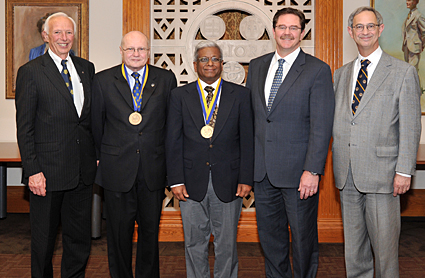 G. Robert Witmer, Jr. ’59, James C. Wyant ’67 (MS), ’69 (PhD); Govind Agrawal, Ph.D.; Robert L. Clark, Ph.D.; and President Joel Seligman
G. Robert Witmer, Jr. ’59, James C. Wyant ’67 (MS), ’69 (PhD); Govind Agrawal, Ph.D.; Robert L. Clark, Ph.D.; and President Joel Seligman
Parachute deployed. We are decelerating. Standing by for back shell separation. We are at power flight. Standing by for sky crane. Sky crane has started. Touch down confirmed. We’re safe on Mars!
Because there was no way to see it, NASA’s mission scientists had to be talked through the agonizing moments leading up to the Mars rover “Curiosity” successfully landing on the red planet in August 2012. Govind Agrawal, Ph.D., professor of optics at the Institute of Optics, and his work with lasers is helping to make seeing something like this in real-time more and more possible.
When it’s not helping us put a webcam on Mars, Agrawal’s work is strengthening the foundation of our modern telecommunications infrastructure. A leading expert in optical communications, Agrawal is a fitting selection for the inaugural Dr. James C. Wyant Professor in Optics.
On October 28, Agrawal was installed as the Wyant Professor in the Hawkins–Carlson Room of Rush Rhees Library in the company of family, friends, and many faculty members, students, and staff from the University community. For all the celebrating of Agrawal’s achievement, there was equal time spent honoring the generosity that made it possible. For that, the ceremony recognized University Trustee James C. Wyant ’67 (MS), ’69 (PhD).
“Jim’s career in teaching, scholarship, and the practical application of optics has truly made him a leader in optical science,” said President Joel Seligman. “As a new trustee, Jim has already become a valuable member of the University’s Board, which values his wise counsel and great support of our University.”
This is the second professorship in the field of optics Wyant has established at the University. The first honored his former professor, the late M. Parker Givens, a highly revered teacher to generations of students at the Institute of Optics.
Wyant is professor emeritus at the University of Arizona’s College of Optical Sciences, where he also served as director and dean. He has been a visiting professor at the Institute of Optics since 1983 and has returned to Rochester annually to teach in the Institute’s summer school for 29 of the past 30 years. Wyant also supports the Institute through his George Eastman Circle membership, and he is a member of the Dean's Advisory Committee for the Edmund A. Hajim School of Engineering & Applied Sciences.
Wyant is a former president of the Optical Society of America (OSA), with which Agrawal has also been extensively involved. Agrawal is a fellow of the OSA and the Institute of Electrical and Electronics Engineers (IEEE). In 2012, the IEEE presented him with its prestigious Quantum Electronics Award. He is also the 2013 recipient of the University’s William H. Riker University Award for Excellence in Graduate Teaching.
Agrawal has authored or coauthored more than 400 research papers and eight books including Fiber-Optic Communication Systems (4th edition, Wiley 2010) and Nonlinear Fiber Optics (5th edition, Academic Press 2013), graduate studies texts which have helped train a generation of scientists.
“Not only has Govind been prolific in his scholarly efforts, but in his domain, his work has been highly valued, being cited thousands and thousands of times,” said Robert L. Clark, dean of the Edmund A. Hajim School of Engineering & Applied Sciences and senior vice president for research. “We have an outstanding scholar who is applying his talents to research, to education, and in service to the Institute of Optics.”
Agrawal is also a professor of physics in Arts, Sciences & Engineering and a senior scientist at the Laboratory for Laser Energetics. His research interests include optical communications, semiconductor lasers, nonlinear fiber optics, and silicon photonics.
Golisano Children’s Hospital Progress, Block by Block
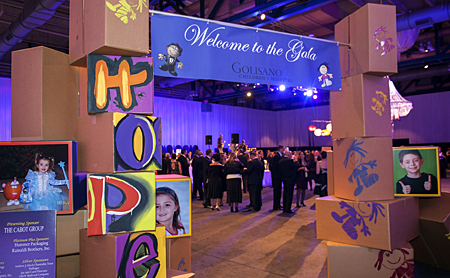 Brick by brick, the new Golisano Children’s Hospital is steadily rising.
Brick by brick, the new Golisano Children’s Hospital is steadily rising.
In celebration of the building’s progress, the 26th annual Golisano Children’s Hospital Gala, held on October 19, used a theme of children’s blocks to decorate the Rochester Riverside Convention Center and to emphasize the continuing achievements toward our goal of building one of the country’s preeminent children’s hospitals.
More than 800 elegantly dressed guests attended the Hospital’s premier annual fundraising event. They enjoyed dinner and lively entertainment and participated in silent and live auctions to raise funds to create the interior environment of rooms where patients and families will take respite in the hospital.
As the evening came to an end, generous benefactors had contributed approximately $625,000 in support of the new building and the people and programs that will make this a destination for patients and families across the state.
Honorary Chair Gary Mauro continued his unwavering support of Golisano Children’s Hospital. His business, J.T. Mauro Company, provided complete mechanical systems for the Children’s Hospital’s Pediatric Intensive Care Unit (PICU) and Pediatric Cardiac Intensive Care Unit, as well as the William and Mildred Levine Pediatric Surgical Suite projects. The company has also funded a PICU nurse’s station and has been a sponsor for the Miracle Maker’s Luncheon every year since its inception. Gary has been involved with the Gala and golf tournament committees for many years. Most recently, J.T. Mauro committed $150,000 to name the atrium balcony in the new Children’s Hospital.
Mike Smith of The Cabot Group, this year’s presenting sponsor, has been a member of the Children’s Hospital board for three years. The 2010 Miracle Maker Award recipient for outstanding commitment by a corporation, The Cabot Group has continuously recognized the Hospital’s needs and invested in the future care of our community’s children. This year marked the fifth time The Cabot Group has been the presenting sponsor of the Gala. In 2008, the company committed to sponsoring the event for 10 years.
The funds raised throughout the evening will support Golisano Children’s Hospital’s $100 million campaign. Launched publicly at the 2011 gala, the campaign supports major enhancements to several pediatric programs and is part of the University of Rochester Medical Center’s $650 million campaign and the overall $1.2 billion goal of The Meliora Challenge: The Campaign for the University of Rochester.
To see photos from the gala, click here.
Centennial Celebrations at the Gallery
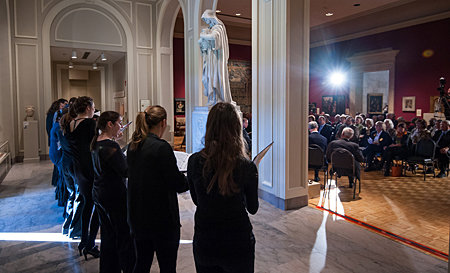 An October 8, 2013 ceremony marked the rededication of the original 1913 Memorial Art Gallery.
An October 8, 2013 ceremony marked the rededication of the original 1913 Memorial Art Gallery.
A man with Alzheimer’s disease offers his critiques while touring the Memorial Art Gallery with his wife. He shares how the art speaks to him. Afterward, his wife is asked how it was meaningful. The woman answers “It gave me my husband back.”
While visiting a temporary exhibition, a school teacher points out a student who hasn’t said a word in 10 weeks that now can’t stop talking about a painting.
We have to believe these are among the types of experiences Gallery founder Emily Sibley Watson had in mind when she sought an art museum for the edification and enjoyment of all of Rochester’s citizens.
On October 5, 350 guests began celebrating 100 years of the Memorial Art Gallery at the Centennial Gala that remembered Watson for helping to define and shape Rochester’s cultural strength and richness. The evening also recognized the remarkable 50-year leadership of the Herdle family: George Herdle, the Gallery’s first director; Gertrude Herdle Moore, the Gallery’s second and longest-serving director; and Isabel Herdle, the Gallery’s associate director.
The memories of these important early leaders in the Gallery’s history were further honored on October 8 at the rededication of the 1913 building.
“We, like the Watsons and Herdles, know that this museum offers every visitor a place for understanding and reflection, and if we’re lucky, a place of mystery, wonder, and delight,” said Grant Holcomb, the Mary W. and Donald R. Clark Director of the Memorial Art Gallery. “The Gallery brings something different to everyone.”
Holcomb was joined by President Joel Seligman; James Durfee, president of the Gallery’s Board of Managers; several dignitaries, and guest of honor, Anastasia Watson Markson. In the Renaissance Gallery, Markson, as a member of the Watson family, helped formally dedicate what will now forever be known as the Watson Family Foyer.
The Gallery’s centennial celebration, culminated with a public “birthday party,” on October 13. Attendees enjoyed hands-on art activities, storytelling, guided tours, music and dance performances, birthday cake, and more.
A vision Emily Watson had more than 100 years ago—to bring art to the community—is now readily seen through the Centennial Sculpture Park, which invites the community to enjoy the Gallery’s grounds. The Sculpture Park is among the priorities of the Gallery’s “Gateways to Art” campaign, which has raised more than $25 million.
Bolstering the endowment is the campaign’s primary objective. Fortunately, the Gallery has friends like eight-year-old Jonathan Hacker who, after visiting with his mother gave $.26 to keep his museum open forever.
To see photos from the events celebrating the centennial anniversary, click here.
University Mourns Loss of Eastman Dean Douglas Lowry
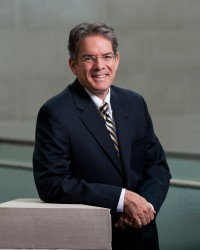 The University community continues to cope with the loss of Douglas Lowry, who served as the Joan and Martin Messinger Dean of the Eastman School of Music, who died Wednesday, October 2. He will be remembered as a composer, conductor, and academic leader who was keenly attuned to the shifting music world and its challenges for music schools and students.
The University community continues to cope with the loss of Douglas Lowry, who served as the Joan and Martin Messinger Dean of the Eastman School of Music, who died Wednesday, October 2. He will be remembered as a composer, conductor, and academic leader who was keenly attuned to the shifting music world and its challenges for music schools and students.
“Doug was a remarkable University leader. He brought together the Eastman community in ways that were deeply appreciated by its faculty, staff, students, alumni, and friends,” said President Joel Seligman. “He was the leader during whose watch the School renovated and expanded Eastman Theatre. Inspiring new faculty members were hired. Doug was a national presence in music education and an individual whose charm, wit, and intelligence inspired generations of students and colleagues.”
The Main Hall, the atrium that connects the Eastman School of Music and the Eastman Theatre, will be re-named Lowry Hall in Doug Lowry’s honor. Family, friends, colleagues, and admirers will gather in Kodak Hall at Eastman Theatre for a memorial celebration on November 3 at 3 p.m.
Memorial gifts may be directed to the Douglas Lowry Fund for Musical Excellence to support Dean Lowry’s vision and the mission of the Eastman School of Music.